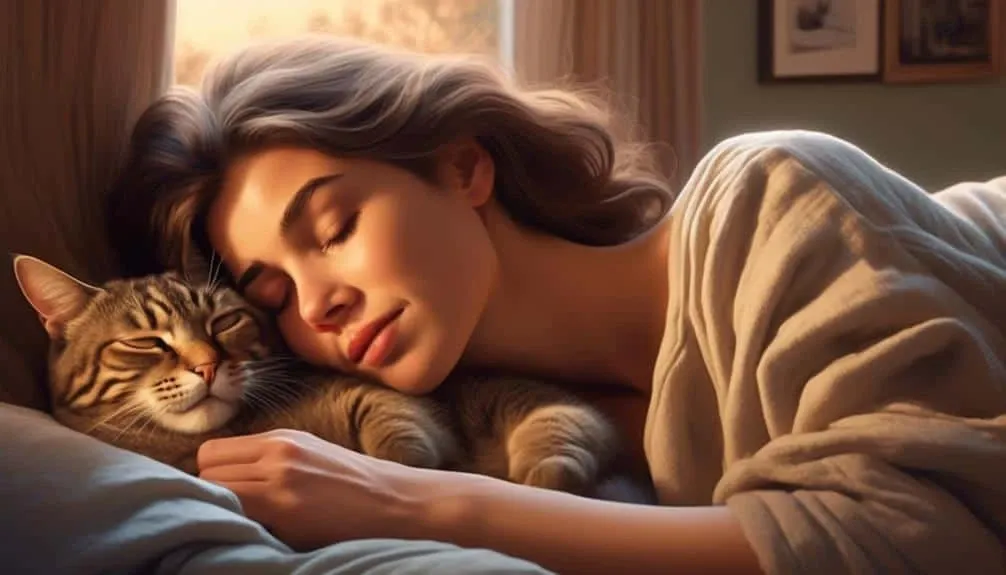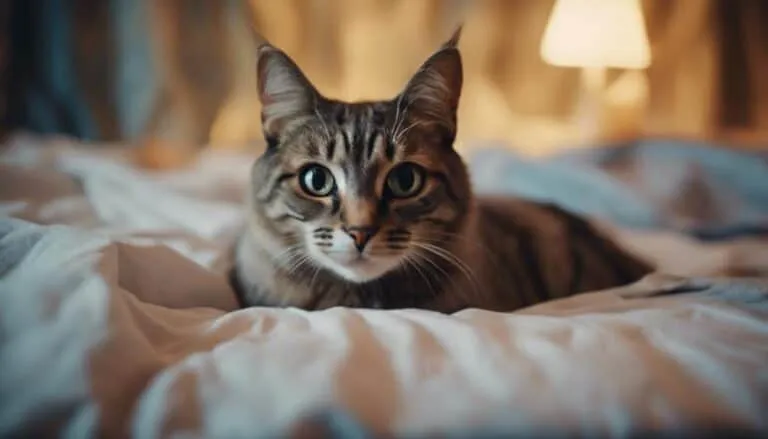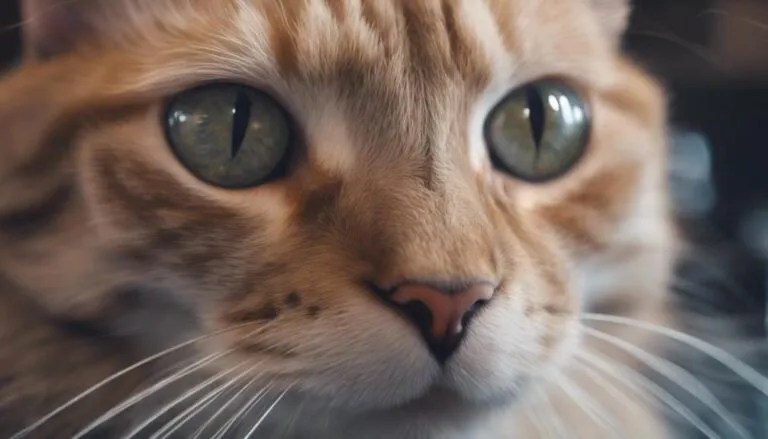The Best Fluffy Pancakes recipe you will fall in love with. Full of tips and tricks to help you make the best pancakes.

By pure coincidence, many cat owners have experienced the surprising habit of their feline companions placing their paw on their face. This peculiar behavior has left many puzzled, wondering about its meaning and significance.
In this article, we will explore the various theories surrounding this intriguing gesture, from the motivations behind it to the potential consequences and hygiene concerns.
Get ready to uncover the secrets behind cats' surprising habits as we dive into the fascinating world of pawing on your face.
Key Takeaways
- Pawing on the face can serve multiple purposes, including seeking attention, marking with scent, expressing love, and indicating a desire to play.
- Scent marking behavior through rubbing helps cats assert dominance, establish territorial boundaries, attract potential mates, and create a familiar and secure environment.
- Pawing can be a way for cats to show affection, mark territory, seek attention, and strengthen the bond between cats and their owners.
- Pawing during grooming or feeding time, engaging in shared activities, and adding fun to mealtime routines are ways that pawing can enhance the bond between cats and their owners.
Reasons for Paw on Face
Cats often place their paw on your face for various reasons. One reason is seeking attention. They may want you to notice them and give them some affection. Another reason is marking you with their scent. Cats have scent glands in their paws, so by touching your face, they are leaving their scent behind, marking you as part of their territory. Expressing love is another possible reason. By placing their paw on your face, cats may be showing affection and wanting to be close to you. Indicating a desire to play is also a possible reason. Cats may use their paw to gently tap your face as a way of inviting you to engage in playtime. Additionally, pawing can serve as a form of dominance display. By placing their paw on your face, cats may be asserting their authority and establishing their position in the hierarchy. Understanding these underlying motives can help us better interpret and respond to our feline companions' actions.
Scent Marking Behavior
Scent marking behavior is a common and instinctual way for cats to communicate and establish their presence within their territory. Cats employ various scent marking techniques to leave their unique odor on objects and surfaces, signaling their ownership and territorial boundaries.
By rubbing their face, body, or paws against different items, cats release pheromones, chemical substances that carry specific messages to other cats. This behavior allows cats to assert their dominance, attract potential mates, and create a familiar environment that provides them with a sense of security.
Territorial behavior and scent marking go hand in hand, as cats use their scent to mark their territory and communicate with other felines. Understanding these scent marking behaviors can help cat owners interpret their pets' communication cues and create a harmonious living environment for both humans and cats.
Showing Love Through Pawing
Pawing is a common and affectionate way for cats to express their love towards their owners. Cats have unique ways of showing their affection, and pawing is one of them. Here are some reasons why cats use pawing as a form of affection:
- Pawing as a form of affection: Cats may gently tap or knead their owners with their paws to show love and affection. This behavior is similar to how kittens knead their mother's belly to stimulate milk production. It's their way of expressing comfort and contentment.
- Pawing as a territorial behavior: Cats have scent glands in their paws, and by pawing at their owners, they're marking them with their scent. This behavior is a way for cats to establish a sense of ownership and territoriality, showing that you belong to them.
- Pawing to get attention: Cats are intelligent and know that pawing can grab their owner's attention. By pawing at their owner's face, they're seeking interaction, playtime, or simply wanting to be noticed.
- Pawing as a sign of trust: Cats are vulnerable when they expose their bellies, and pawing is a display of trust. By allowing their paws to touch their owner's face, they're showing that they feel safe and secure in their presence.
Understanding these various reasons behind pawing can help cat owners better interpret their feline companion's behavior and strengthen their bond.
Pawing as a Form of Play
Engaging in playful behaviors, pawing serves as a form of interaction and entertainment for cats. When it comes to grooming, cats may use their paws to playfully engage with their owners. They may paw at their owners' hands or brushes, mimicking the act of grooming themselves. This playful behavior can strengthen the bond between cats and their owners as they engage in a shared activity.
Similarly, cats may also engage in pawing during feeding time. They may use their paws to playfully bat at their food or paw at their owners to indicate their eagerness for a meal. This form of play during feeding can add an element of fun to the mealtime routine for both cats and their owners.
Sign of Trust and Bonding
A cat placing its paw on your face can be a significant indicator of trust and bonding between the cat and its owner. This gesture is a way for the cat to build trust and strengthen the bond with its human companion.
Here are four reasons why a cat may place its paw on your face:
- Affection: When a cat puts its paw on your face, it's showing love and affection towards you. This gentle touch is a way for the cat to express its feelings and establish a deeper connection with you.
- Comfort and security: By placing its paw on your face, a cat may feel safe and secure in your presence. It's a way for the cat to seek comfort and reassurance from its trusted human companion.
- Mutual grooming: Cats engage in mutual grooming as a bonding behavior. Placing their paw on your face is a way for them to mimic this grooming behavior and strengthen the bond between you.
- Communication: Cats communicate through body language, and placing their paw on your face can be a form of communication. It can convey a sense of trust and closeness, indicating that the cat feels comfortable and at ease with you.
Understanding these reasons can help you better interpret your cat's behavior and enhance the trust and bond you share with your feline friend.
Cats Mimicking Human Behavior
The behavior of cats mimicking human actions is an intriguing aspect of their social interaction and communication. Cats imitating human gestures, such as putting their paw on your face, is a form of affectionate behavior. It's believed that cats observe and learn from their owners, and mimicking behavior is a way for them to interact and communicate with humans.
However, it's important to note that not every action has a specific meaning or intention behind it. Sometimes, a cat's paw on your face may be a coincidence and related to stretching. Deciphering a cat's body language is crucial in understanding their motives.
It's also important to consider potential consequences and hygiene concerns. Accidents can happen when a cat places its paw on your face, leading to scratches, and having a cat's paw on your face may not be hygienic due to potential diseases and infections. It's advisable to wash hands after petting a cat and avoid letting them sleep on your pillow.
Observing and Learning From Owners
Observing and learning from their owners, cats acquire knowledge and behaviors through careful observation and imitation.
Cats are highly attentive animals and are constantly observing behavior patterns and learning from human interactions. They watch their owners closely, studying their movements, vocalizations, and reactions. By doing so, they gain insight into how humans communicate, interact, and navigate their environment.
Cats are skilled at mimicking human behavior, such as putting their paw on your face, which they may have learned by observing their owners. This behavior is a way for cats to interact and communicate with humans, showing love, seeking attention, or even establishing personal space.
Interacting and Communicating With Humans
By closely observing their owners and learning from their behavior, cats gain valuable insights into how to interact and communicate with humans. This understanding enables them to engage in meaningful interactions with children and effectively convey their needs and emotions.
One key aspect of interacting with humans is understanding cat body language. Cats use subtle cues such as tail movements, ear positions, and vocalizations to communicate their intentions and emotions. By paying attention to these signals, humans can better understand what their feline companions are trying to convey.
Additionally, cats may mimic certain behaviors exhibited by their owners, such as placing their paw on a person's face, as a way to establish closeness and trust. However, it's important to respect a cat's personal space and boundaries during these interactions.
Establishing Personal Space Boundaries
Cats assert their personal space boundaries by using their paws as a means of communication. When a cat rests its paw on your face, it's important to respect their boundaries and understand their body language. Here are four key points to consider:
- Respecting feline boundaries: Cats use their paws to establish distance between themselves and their owners. Resting a paw on your face can be a way for them to communicate their need for personal space.
- Importance of body language: Deciphering a cat's body language is crucial in understanding their motives. Not every action has a specific meaning or intention behind it, but observing their body language can help us better understand their boundaries.
- Hygiene concerns: Having a cat's paw on your face may not be hygienic due to potential diseases and infections. It's important to wash your hands after petting your cat and avoid letting them sleep on your pillow.
- Potential consequences: Accidents can happen when a cat places its paw on your face, resulting in scratches. Being mindful of their boundaries and responding appropriately can help prevent any unintended injuries.
Stretching and Coincidental Pawing
When a cat places its paw on your face, it may sometimes be a result of coincidental pawing during their stretching routine. Cats have a natural instinct to stretch their muscles, especially after periods of rest or sleep. During this stretching process, cats often extend their paws and flex their claws.
In some cases, their paws may come into unintentional contact with nearby objects, including your face. This coincidental stretching can lead to a cat's paw landing on your face, even though it wasn't their intention to do so.
It's important to note that not every action of a cat has a specific meaning or intention behind it. Understanding a cat's body language and recognizing the possibility of coincidental pawing can help in deciphering their motives.
Frequently Asked Questions
Can a Cat's Paw on Your Face Cause Any Harm or Injuries?
A cat's paw on your face can potentially cause harm or injuries, such as scratches. To prevent injuries from cat pawing behavior, it is important to establish boundaries, wash hands after petting, and avoid letting them sleep on your pillow.
What Are Some Potential Diseases or Infections That Can Be Transmitted Through a Cat's Paw on Your Face?
Zoonotic infections, such as ringworm and cat scratch disease, are potential risks when a cat's paw touches your face. Preventive measures include regular handwashing, avoiding close contact with cats' paws, and keeping their sleeping areas separate from yours.
How Should You Respond if Your Cat Consistently Puts Its Paw on Your Face?
To discourage a cat from consistently putting its paw on your face, one can utilize training techniques such as redirecting their attention to a toy or providing them with an alternative behavior. Positive reinforcement can be beneficial in modifying cat behavior.
Are There Any Specific Body Language Cues to Look Out for to Understand a Cat's Motive Behind Placing Its Paw on Your Face?
Understanding cat body language is key to deciphering a cat's motive behind placing its paw on your face. Look for cues like tail position, ear movement, and pupil dilation. Tips for handling a cat's paw on your face include respecting their boundaries and maintaining good hygiene.
Is It Safe to Let Your Cat Sleep on Your Pillow Despite Their Pawing Behavior?
It is generally not recommended to let your cat sleep on your pillow due to hygiene concerns. Alternatives include providing a separate sleeping area for your cat and ensuring they have a comfortable bed nearby.
Conclusion
In conclusion, the habit of cats placing their paw on a person's face is a complex behavior with multiple motivations. Whether it's for attention, scent marking, affection, play, or communication, cats use this gesture to interact with their human companions.
It's important for cat owners to understand and respect a cat's boundaries while also considering the potential hygiene concerns and risks associated with this behavior.
Interestingly, a study found that approximately 65% of cat owners reported their cats engaging in this pawing behavior, highlighting its prevalence among feline companions.








